5 Property valuation methods to value your real estate investment
Property valuation is vital not just to sell your project, but also to borrow against when purchasing. You can use many different methods to value a property, but not all are well known. This blog post will discuss five of the most common property valuation methods and how they work.
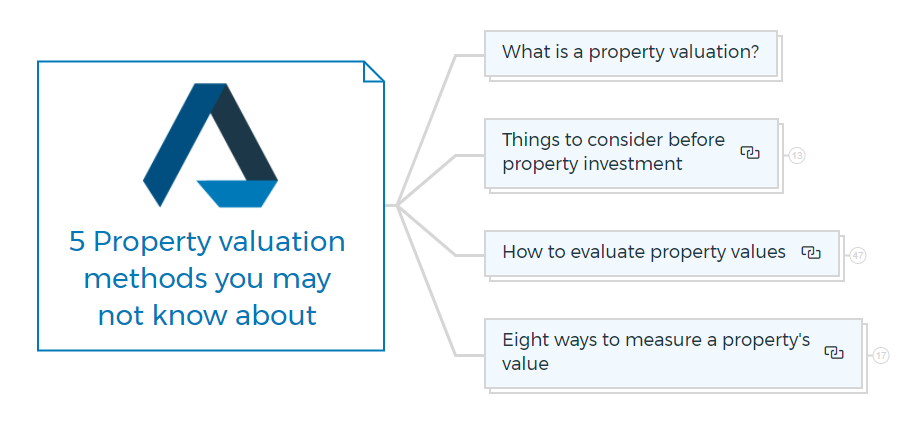
Key Takeaways
What is a property valuation?
The goal of a property valuation is to judge the capital worth of the right to earn regular streams of income for a set or indeterminate length of time.
The property valuation may be made on behalf of the owner as a part of marketing advice, for a potential investor, or for a third party considering granting a loan secured by the property.
The vast majority of property appraisals depend on market value, which is defined as:
The projected amount for which a property should exchange on the appraisal date between a willing buyer and a willing seller in an arm's length transaction following effective marketing.
Even if a property seems identical to an adjacent one, it occupies a different site, which may affect its value. Real relevance resides in the quality and quantity of the particular income, legal title limitations, and legal restraints, such as using the premises and the landlord-tenant relationship.
Things to consider before property investment

1. The building
The investor prefers a new, well-designed, flexible building for future demand fluctuations. The location of the site is also important.
If repairs are needed, they should be quick, inexpensive, and not reliant on proprietary parts that may become hard to obtain over time. You may tolerate a few minor flaws, but multiple major flaws may reduce the market for tenants and buyers, affecting rental and capital prices.
2. The site
The site is vital. The valuer will evaluate the site's suitability for the project. Considerations include if it's large enough and meets any specific needs and whether it has appropriate off-site parking and loading/unloading facilities.
3. Lease terms
The lease oversees landlord-tenant interactions during its tenure and sometimes afterwards. A poorly written lease is likely to show up in any dispute.
A lease's provisions affect rental and capital values, and you should examine it carefully. Landlords desire a modern institutional lease with a term of 15 to 25 years, with upward only rent reviews every five years, and with the tenant responsible for all repairs, maintenance, and insurance costs, including rent loss coverage in the event of damage or loss.
Not every property is acceptable for a lease, and the final terms are usually negotiated. The owner of a major complex may insist on a standard lease, in which case the prospective tenant must accept it or decline a unit.
4. Rent
The valuer will ask about the current rent payable, how often it's paid, when it's due, whether it's paid in advance or arrears, and what punishments are available for late payments.
The tenant would be responsible for all repairs, maintenance, and insurance. The landlord's obligation is ambiguous if some outgoings remain.
A larger return than required on a full repairing lease is likely to reflect this disadvantage and uncertainty. If the rent paid is less than the rental value, the valuer must determine the market rent.
5. Rental value
Any property valuation must consider the net income. If the landlord is responsible for repairs or insurance, these costs should be factored into the net rent.
Estimating the present value requires market judgement, which adds to the appraisal process. Notably, the typical property valuation technique does not attempt to predict the rental value to the first payment date.
The valuer must estimate the current rental value at the time of appraisal and include it in the valuation from the earliest date enforced.
The valuer estimates rental value by analyzing relevant rent level information but may not be aware of all transactions. They will use it to determine the rental value of the unit under review, keeping in mind that not all evidence may be relevant or relate to comparable properties.
6. Rent reviews
Realistic rent helps sustain the investment's value. Modern agreements usually include periodic rent evaluations.
Most landlords don't want a 5-year rent fix. The review will take the form agreed upon by the parties under the lease. The upward-only review is the most popular, although there are others.
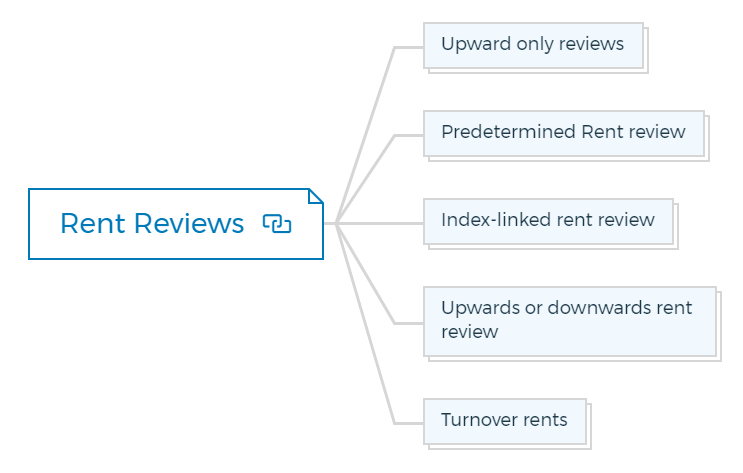
Upward only reviews
The rent is reassessed at scheduled periods. The rent will be larger than the rent paid immediately before the review or the full rental value on the review day.
Even if the rental value drops, the minimum rent will be the prior period's rent.
Predetermined rent review
The landlord and tenant agree to escalator rents at the start of the lease. Both parties benefit from the assurance of future payments and the expense savings from not needing surveyors or court or arbitration referrals. Lack of market rent may benefit the landlord or renter.
Index-linked rent review
The parties agree that the rent will fluctuate based on an index like the Retail Price Index (RPI). As with other rent reviews, it may vary annually or periodically. External indices' bases may vary, or they may not reflect rental value factors.
Upwards or downwards rent review
Rent is assessed periodically and may increase or decrease based on real estate market conditions. It ensures that rent, a major overhead, doesn't exceed commercial expectations.
Turnover rents
Turnover rents typically include a fixed base rate plus a percentage of the turnover. The agreement provides an annual review, which may be upward or downward depending on trading profitability.
Outgoings
Landlords try to let on full repairing and insuring terms, where the tenant is responsible for all repair and maintenance costs and extensive building, plant, and machinery insurance.
When a property is rented on these terms, the valuer merely considers the landlord's administration costs. In other circumstances, an estimate of the expected annual maintenance or other expenses for which the landlord is liable is needed, together with any accrued repairs or maintenance.
The costs of management include:
- An annual management charge.
- Yearly amounts for rent reviews and lease renewals.
- Periodic assessments for insurance cover are not included in the basic management price and are not recoverable by the landlord.
Based on experience managing similar properties, outgoings are sometimes estimated as a percentage of rental value.
The full repairing and insuring lease is crucial to landlords for two reasons. First, if the landlord retains responsibility for an outflow, identifying and organizing any work is expensive and erodes rental income.
Second, annual costs tend to rise, lowering the real value of fixed rent. The market prefers greater yields when the landlord has considerable repair responsibilities. It may also avoid investments where landlords are heavily involved in outgoings.
Value added tax
Generally, lease rent is VAT-free. A landlord can tax an exempt supply, making it taxable. If a landlord chooses this option, rental income from exempt properties becomes standard rated. A landlord would use this method to reclaim input tax.
Once the landlord opts to tax, all supplies must be standard rated. The landlord should consider the tenant's or buyer's status before taxing. Taxing may not be a wise business decision if the tenant or buyer can't recoup the VAT.
VAT is ignored when an investor opts to tax and can reclaim VAT on certain payments. If the department or organization hasn't elected to tax or charge a modified rate, they should address the transaction's effect and net cost.
How to evaluate property values
Many elements must be considered when determining what a property is worth today and what it might be worth. Appraisers employ five property valuation approaches to identify property value, including value benchmarks, financial ratios, financial forecasting, and value judgments.

1. The comparative method
This approach is also known as the sales comparison approach in real estate. We define compare as 'to study to find resemblances or contrasts'.
The valuer must assess similarities and variances and make modifications to reflect these differences. These distinctions are called value determinants or value impacting elements in real estate valuation.
The strength of the tenant's covenant, the lease terms, and the property's tenure all contribute to the capital value. Consider these factors in analysing real estate transactions involving comparable properties to appraise one.
They are distinct but tightly connected; interpretation is often challenging, requiring judgement and experience. In the comparative technique of property valuation, the following factors shape the property's value:
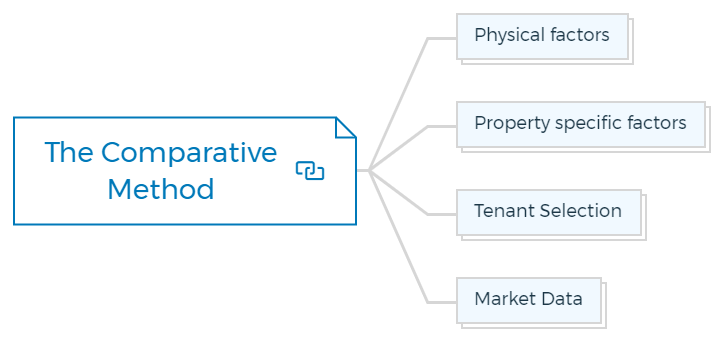
Physical factors
Physical aspects concern the property's nature, size, and location. Every structure in space impacts its surroundings and is influenced by its environment.
Location - Location is crucial. A property in the correct location will always be valuable. The type of use will influence location. A distributor of high-end portable electronic equipment may prefer the privacy of an unmarked unit at the back of a bland industrial estate, whilst a prestigious law practice may insist on a conspicuous position.
Topography - It is about the land's physical form. A level site is preferred as a steep slope site presents unique construction, drainage, and accessibility challenges for the disabled. Levelling a land can be costly, especially if retaining boundary walls are involved. Maintenance may be more costly.
Accessibility - It reflects the site's proximity to existing road, rail, sea, and aviation infrastructure. But it also pertains to the site's physical access points.
A site with only one access point may be at a disadvantage and consequently less valuable than a site with two access points.
Geology - Geology, unlike topography, investigates the ground's physical composition. Geology may favour a site with a high load-bearing capacity for several purposes.
Due to uneven settlement and poor ground conditions, fault lines, clays, and sand may impede growth. No one can blame nature. Sites could be polluted, making them undeveloped and costly to remediate.
Property specific factors
It includes construction, maintenance, age, condition, layout, and specification.
Construction - Good solid construction is a consequence of using durable and time-tested materials in traditional ways. But where new technologies are used, and the skills required to manufacture them are still experimental, you may incorporate future problems.
Materials such as high alumina cement, asbestos, sea-dredged aggregates, and wood wool boards are collectively referred to as 'deleterious'.
Age - The value of the houses will reflect their age, as older homes require more repairs and care, which is normally more expensive than a new home, where it is assumed it will require no maintenance for the first few years.
Layout - The property layout is vital. Squares or rectangles are the most cost-effective floor plate for most applications. Today's office occupants demand open areas to meet their needs. The gross to net area ratio measures efficiency.
Gross to net area ratio:
The gross to net area ratio is a method of valuing property that looks at the total square footage of a property and compares it to the usable square footage. It is useful for properties with a lot of wasted space, such as office buildings with large hallways or storage areas.
Tenant selection
Tenant mix is vital for property management from local parades to regional shopping centers. Due to stench and litter, fashion clothing stores will not want to be adjacent to fish and chip outlets.
However, two jewelers or shoe stores next to each other sometimes attract more customers than one shop alone.
Market data
Since valuation is the price estimation, the best market evidence is genuine transactions. Actual sales, lettings, and investment transactions will interest the valuer. In contrast to the stock market, information is not always readily available in one place.
Finding relevant transactions and analyzing their components is a critical element of a valuer's job. These statistics come from several sources. Here are 10 tips for real estate investors to collect data.
The appraiser's analytical method will differ depending on the property type. Residential property is often approached based on local market knowledge and expertise, whereas commercial property requires an earlier extensive examination.
Properties comparable to the subject property should be inspected and analysed while employing a sales comparison approach. To accommodate variations with the subject property, you should adjust their sales price.

Adjustments depend on several factors -
- The first is the date of sale of the property. You should adjust the sales price for inflation or deflation that has taken place since the selling date.
The first of which is the time when you sell the property. Based on the inflation or deflation that has occurred after the sales date, a factor should be added or may be withdrawn from the sales price.
Example -
The subject house, Property A, is 20 years old. Property B is 20 years old, and a year ago, it sold for $90,000. For one year, the inflation factor is 12%.
$90,000 + (12% X $90,000) = $100,800
Property A is valued at $100,800.
- The second set of modifications depends on whether or not the comparable home has certain amenities or characteristics. Adjust a price value from the comparable property to help calibrate the values.
Example -
The subject property, B, is compared to Property A, which sold for $70,000. Property A has a garage worth $7,000; however, Property B does not.
$70,000 - $7,000 = $63,000
Property B is worth $63,000
Terminologies to use in the comparison approach are -
Market Value:
The likely price that a buyer who is ready, willing, and able to buy but not obligated to do so would pay, and a seller who is ready, willing, and able to sell but not obligated to do so would accept.
Price of sale:
The price at which a buyer pays for a property.
Sales Price:
The price at which a buyer pays for a property.
2. The valuation approach
Valuers have several options when preparing a property valuation with an investment approach.

The all-risk yield approach
The all-risk yield implicitly represents all potential benefits and drawbacks of the investment. Rather than using the all-risks yield, current rents and rental values are employed instead. The use of low yield means no aspect of rental value prediction.
The method is also criticized when the rent paid is not current. The rent for the remainder of the term is valued at a yield below-market evidence because it is more secure.
The reversionary element will be valued at the full rental value when it becomes payable, but only to the present level.
This rental value is subsequently recognized as an ongoing source of revenue. The all-risks yield, which is below current rates on other forms of investments, is used to offset this distortion of predicted performance. The yield is calculated directly from the net rent and the sale price.
An adjustment must consider the lease clauses, including the tenant's repairing and insuring obligations, the property's age and general condition, suitability for the location, any unique features of the building or its site, and the tenant's covenant.
The traditional valuation includes rack-rented and reversionary interests, including any arrangement where the current rent is less than the current rental value.
In some circumstances, the present rent surpasses the real estate market value. In contrast, the rent is fixed for a long time in others, requiring extra analysis and a change in the valuation approach to reflect these limiting variables.
Freehold rack-rented investments
The simplest scenario is the rack-rented investment property. The process entails capitalizing the rent in perpetuity at a suitable yield obtained from market observation and analysis when the rent is at full market value.
The property in freehold tenure let on modern lease terms. In other words, the right to collect current income in perpetuity is capitalized using an all-risks yield calculated directly from recent market transactions.
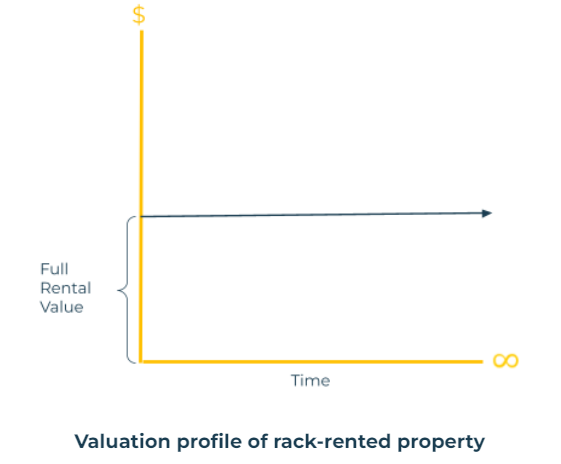
Example -
Value a modern freehold office building occupied by a regional office of an insurance firm that was just let for a 20-year term with five-yearly reviews on a full repairing and insuring (FRI) lease at a rent of $150 000 per year. Recent deals in the area indicate that investors are willing to accept a 7 per cent all-risks yield.
Net rack-rent per annum - $150,000
Years' purchase in perpetuity @7% - 14.28
Capital value - $2,142,000
Freehold reversionary investment
If the last review were a year or more ago, many investment assessments would reflect a lease where the current rent is less than the entire rental value.
If no reviews are scheduled, the investor expects a rise at the next review or the lease's end. The current rental value should be assessed using data from recent lettings of similar properties.
It is stressed that no attempt is made to forecast future rent. This form of property valuation is treated in three ways:
- Term and reversion
- Layer (or hardcore)
- Equivalent yield.
Reversion value
The anticipated terminal or sale value of the property at the end of the holding period aka the future sale price of the property.
Term and reversion (vertical separation)
The term and reversion model treated reversionary investments first. The yield is calculated using market data, usually from rack-rented investments.
This yield is used to value the reversionary rent, which accounts for the majority of the capital value in most current leases.
The term yield is reduced by 0.5-1.0% to reflect the tenant's contractual commitment to the present payment and the reduced risk. The difficulty is that the valuer rarely completely understands the impact of the change on the overall return.
The figure below shows how to separate income flows for valuation purposes.
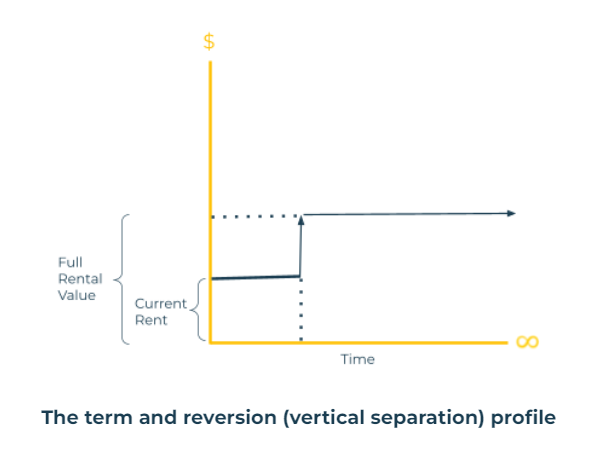
While it may seem reasonable to drop yields where risk is lower, the market does not appear to do so. The risk rate applies to the whole property, not just a component.
As for the assertion that it reflects the market, there is no evidence that it does so. Even if the difference in capital value is minor, the real estate valuer should consider the market's preference for a certain yield before disregarding it and adjusting one element of the income flow.
Layer or Hardcore model (horizontal separation)
The previously mentioned vertical model indicates how income is expected to fluctuate and accounts for the change in income when it occurs. The current variation assumes that the existing (core) income will continue perpetually.
The increase (top slice or marginal rent) is treated as a separate stream in perpetuity but starting at some future date. As a result, core and marginal revenues are artificially separated.
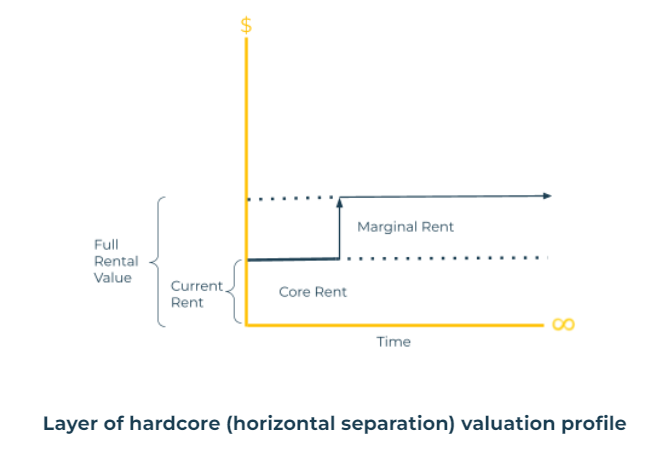
Over-rented property
A property is over-rented if the current rent exceeds the current rental value. This condition is rare, but it poses valuation difficulties when it occurs.
The reasons vary: the renter may have been misled while signing the lease, or the rent agreed upon may have been fair at the time of signing but is now excessive due to the area's decline in popularity.
A new road bypassing a row of stores, on-street parking limitations, or the availability of superior premises nearby at comparable prices could all be why a rental value has decreased. The figure below depicts an over-rented property.
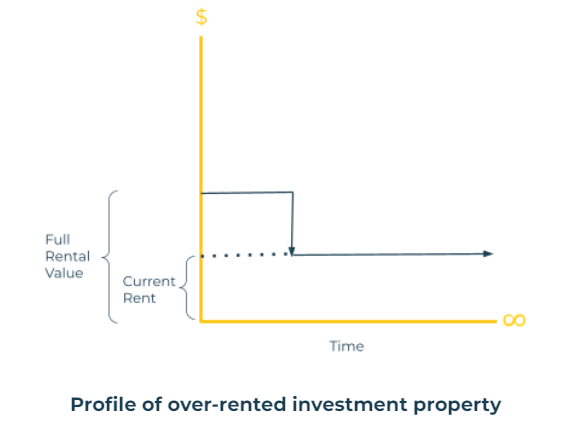
An over-rented property has a small investment market. There is no model for dealing with a valuation, but the landlord should try to resolve it if possible, as it will likely benefit both sides.
Equivalent yield
This method uses two yields: one for the reversionary aspect obtained from market analysis and the other for rent security below market level. The layer model originally had two yields; however, they were derived differently.
The equivalent yield, which utilises the exact yield to value both tranches of the income flow, is gaining support. The reasons provided are that any attempt to modify the employed yields involves a subjective factor lacking evidence.
A lower rent implies less risk, which should be represented in return, but this argument falls apart when both value components are intertwined.
A calculation will disclose the equivalent yield when a valuation depends on two yields.
A sale based on a term and reversion valuation with a 2% margin between the two rates employed. You can use a discounted cash flow calculation removing growth to find the equivalent yield.
Rents fixed for long periods
Some investments have letting terms that differ from the standard modern lease. It may be that there are no or few rent reviews. Both scenarios necessitate careful care.
Real estate investors like properties with regular rent reviews that allow rent to be adjusted to market value. As a result, a lease's lack of periodic rent reviews affects the capital value. Whereas the standard is five years, ten years would be unappealing to potential investors.
A long-term lease without a review is considered contrary to investing in property. Most investors would expect a yield premium before purchasing, and many would pass on the chance completely.
Tenants might expect to pay more rent if their agreement does not allow for regular reviews or if they are scheduled at irregular intervals. Rent is part of their total outgoings, and a higher rent would harm their competitiveness.
The failure to negotiate regular assessments raises issues about the property's fitness and demand. Some early leases for 21, 35, or even 42 years fixed the rent for the entire duration, with the primary goal being to find a decent renter.
The tenant benefited from a provision allowing the lease to be renewed on the same terms except for rent. If these or similar conditions prevail, the rent will remain stable for a long time.
This type of income is considered 'inflation-prone', reflecting characteristics of the fixed-interest investment market rather than property or income growth.
A property investor would be reluctant to consider such an investment and would want to know when he might enter into a new lease on current conditions.
Leasehold interests
The described valuation method is limited to freehold investments. There are leasehold interests where the profit rent is large enough and long enough to represent an investment.
The difference is called ' profit rent when a leaseholder's rent is less than the rental value.' The profit rent may be enjoyed for the remainder of the term or only intermittently if there is no coincidence between the head and sub-leases.
It may maintain a stable relationship where the lease makes such provision, or the financial relationship may vary due to the lack of coincidence between head and sub-leases. Complicated linkages complicate analysis and valuation.
Leasehold properties' terminable interest generates valuation issues not present in freehold buildings.
When interests have a life expectancy of 60 years or more, it is customary to treat the income as received in perpetuity. The capital value of any reversion after that period is anticipated to be a small part of the total capital value.
When the interest is for a shorter period, it is common to assume the development of a notional sinking fund to ensure the original capital is replaced. It is argued that you then may calculate the yield from equivalent, freehold investments with significantly more information.
However, because the investment is a leasehold investment, the freehold yield is utilised as a starting point and is often boosted by one or two percentage points.
The amount designated for the notional sinking fund comes from rental income, and a sufficient sum must be available after tax. The sinking fund yield is kept low and safe to prevent default and replenish capital.
Long-term sinking fund payments require both a safe investment and a fixed interest rate. Common net rates are 3–4%. Short-term investments spend most of their revenue on a sinking fund.
Sinking funds are not used to replace capital, but their inclusion in the valuation framework allows a theoretical comparison with freehold. The formula for years' purchase calculates the purchase at the remunerative rate with a sinking fund at the (lower) accumulative rate and tax.
The valuation will be done in stages when the profit rent fluctuates over the investment period, each with its purchase multiplier and sinking fund. When one stage ends and the next begins, the prior fund closes but is not called on because the investment continues to pay an income.
The closed fund's interest assures sinking fund overprovision. Overprovision can be adjusted. The best alternative seems to be a discounted cash flow analysis, but there's no information on what rate of return is acceptable for a complete loss of the original investment.
The size of the profit rent, the period for which it is to be enjoyed, and the investor's risk tolerance will all be factors.
Get The Edge Now!
Discover the transformative power of our FREE EDGE platform and
unlock a world of opportunities at no cost!
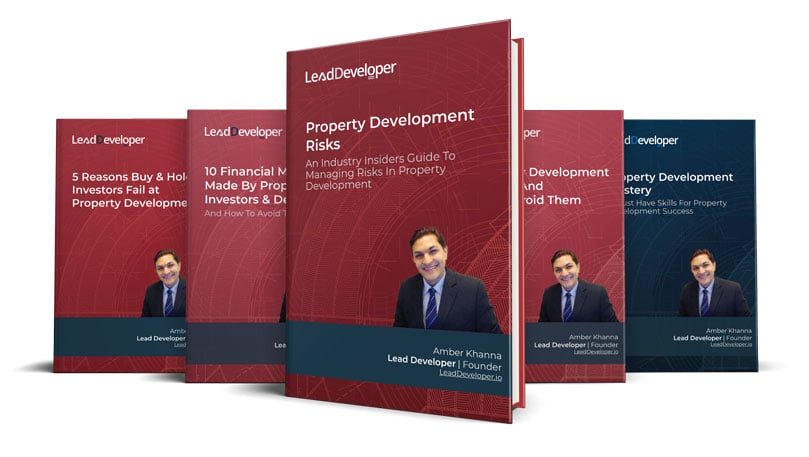
Your Real Estate Toolkit Awaits!
Free eBooks, Courses & Feasibility Suite Trial—Join Today!
✓ Unlimited FREE Trial: Experience the full power of our Feasibility Suite with hands-on demos
—explore without limits, no time pressure & without commitment or credit card!
✓ Learn from Success: Dive into real-life case studies for practical insights.
✓ Engage, Inquire, and Innovate: Ask questions, request features, and engage in lively discussions.
✓ Showcase Your Projects and Gain Insights: Share your projects and get personalised feedback.
✓ Free Resources Galore: Access a treasure trove of free resources,
eBooks & courses to keep you informed.
✓ Exclusive Training: Enjoy members-only training to sharpen your skills.
3. The residual method
Most development land valuations employ the residual method. Preparing a valuation of the anticipated development at completion, deducting fees and finance expenses, indicates the land's worth.
This strategy is complicated because the premises aren't built, designs and costs are tentative, and rentals aren't negotiated.
A completed development is valued based on current rents and yields from market analysis, but the development may not be finished for two or three years. By this time, the market may have changed significantly, affecting value.
Building costs or the cost of short-term finance, or both, may be affected by external events, and any delay in the development schedule is likely to have profound financial implications, especially when the cost of short-term finance is high.
No value profile should create a false sense of its accuracy or certainty, so the valuer must take care to employ the highest-quality data possible.
The technique reflects how the market views the problem; it's a market approach. If the developer owns the land or the price is predetermined, you may use a different method.

The valuer will utilise the information gathered to determine the site's residual value. Suppose the developer already owns the property, or the price is set. In that case, the developer may want to know how much money is available for construction or the minimum value of the completed development required to justify paying a specific land price.
The figure below depicts the main variables.
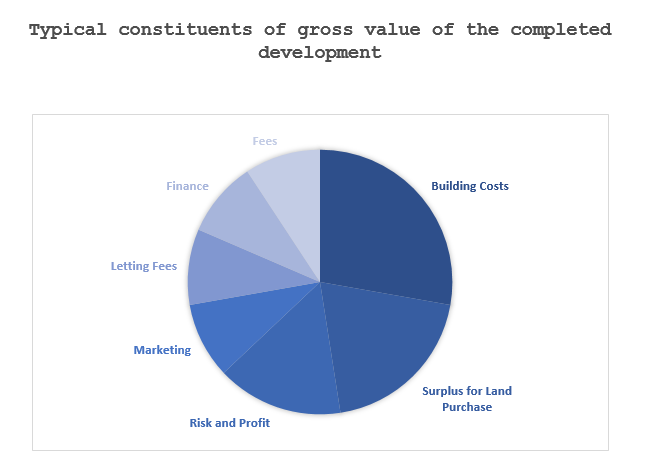
How to calculate the value
First, estimate the completed development's gross development value. Let table floor space multiplied by unit letting value equals total rental value. Analysis of sale prices of similar developments and market demand for yields determine a yield. The investment method is evaluated here.
The end value is usually clear, with a perpetual rack-rent for freeholds or a ground lease for leaseholds. When the stake is leasehold, the frequency and character of the head leasehold interest's rent reviews will affect the yield, as would any peculiar lease restrictions that limit the developer's capacity to manage and operate the development effectively.
The expected transfer expenses are removed from the final assessment because it is assumed that he would sell the development upon completion.
Development costs
The developer is deciding whether to make an offer for the location. At this stage, it wouldn't be cost-effective to produce complete plans; thus, the valuer likely has just provisional information.
The results of the calculations will indicate the site's potential interest. If so, the developer will prepare extra details to refine costs. The main elements of cost are -
- Building Costs
- Professional fees
- Building contract
- Contingencies
- Short term finance
- Land Acquisition
- Construction
- Void Period
- Advertising and marketing
- Agency fees
- Developer's profit
Value of land
Deducting gross development costs from net development value yields the gross amount available for land purchase. The remaining sum, the surplus, covers the cost of the site, fees, stamp duty land tax, and finance expenses in obtaining the site and holding it until the development is completely let and income-producing.
The net amount after costs is not a value in the literal sense but rather an indicator of the maximum bid a developer can afford to make for a site based on the facts available.
Example -
The land is worth $100,000. The discount rate is 10%. How much must the land earn?
$100000 x .10 = $10,000
The exact property should generate $40,000 in profit. What will be the net profit from the construction?
$40,000 - $10,000 = $30,000
Example -
The property is worth $100,000. The rate of capitalization is 10%. Based on a 25-year useful life (100%/25 years), the recapture rate is 4%. The rate of capitalization for the construction is 15% (10% + 5%). What will be the estimated building value and the property's final value?
Estimated value -
$30,000/.15 = $200,000
The property's final worth -
$200,000 + $100,000 = $300,000
4. The profits principle
The profits concept is largely used to construct a method for valuing enterprises with some degree of monopoly or uniqueness based on earnings.
There is an understanding that they cannot be appraised using other methods because there are no comparable properties or businesses to compare them to. The primary method uses final accounts or other trading data to calculate gross and net profits.
The renter is then compensated for the management experience and interest in the capital employed in the firm. The divisible balance is then assumed to be available for equal distribution between the business trader and the owner.
The balance is generally distributed equally. The goal is to show everyone's contribution to the company's success.

Use of profits principle
The profits principle is employed when other tactics won't work. Valuers that specialize in the business activity in question use it. If the valuation is for a rating or compulsory purchase, the valuer should also be familiar with the statutory provisions.
Four situations may require the valuer to determine rental or capital values:
- Property valuations (for financial statements displaying real estate holdings as business assets)
- Assessments for non-domestic rates
- Assessment of compensation on compulsory purchase
- On sale as a going concern.
How are assets treated in the final accounts?
Fixed assets include tangible and intangible assets and investments: land and buildings, plant and machinery, fixtures, fittings, tools and equipment; intangible assets reflect goodwill, patents, licenses, trademarks and similar rights and assets.
There is no uniform approach regarding goodwill; however, it should be included if a value exists or if it was obtained from a prior owner.
Net current assets include stock, debtors, and cash minus the firm's short-term debts, such as trade creditors, bank overdrafts, and tax arrears.
Profitability
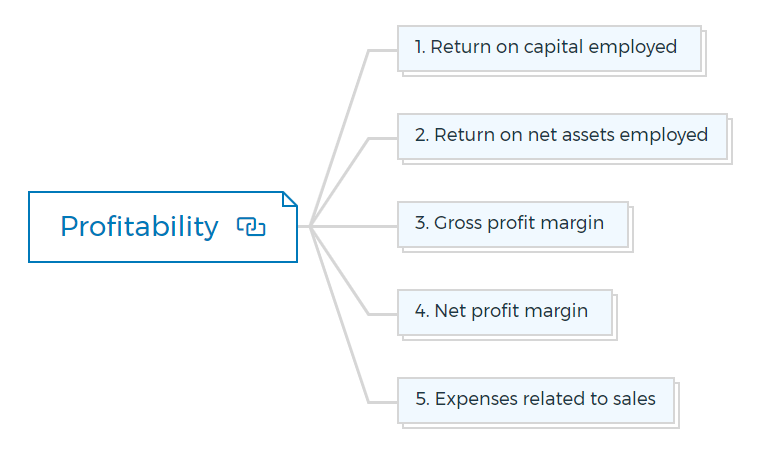
1. Return on capital employed

The profits of a company are proportional to the capital invested by the owner. The rate of return should be higher than that obtained by putting money in a somewhat safe investment like a building society account.
The owner would expect a considerably higher return for the unpredictability and greater risk assumed in investing funds in a firm.
2. Return on net assets employed

This metric compares profitability to the value of the company's net assets. The total of fixed and current assets is subtracted from any current liabilities to arrive at net assets.
Fixed assets are likely to be recorded in the accounting at their acquisition cost less depreciation, which may not accurately indicate their current value.
3. Gross profit margin

Although an industry-standard is likely, overstocking and subsequent sales could increase the profit margin. The gross profit must be sufficient to pay all of the company's operating costs.
As a result, a high turnover rate may present an opportunity to reduce unit costs or provide discounts to some clients.
4. Net profit margin

Unlike the gross profit margin, the net profit margin helps determine the efficiency of a business, and it is beneficial when data on the performance of other similar businesses is available.
5. Expenses related to sales
This statistic will show the amount of money spent to attain the current level of sales. The owner may then assess if more sales can be made without increasing the resources used or whether there is a more efficient and cost-effective way to make the sales.
Liquidity
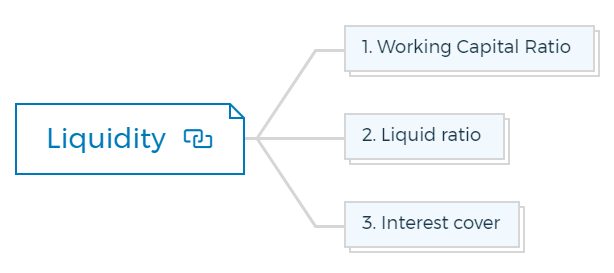
1. Working capital ratio

It is a measure of the current asset-to-current liability relationship. Remember that a ratio of less than 2:1 may indicate instability. You should check a too high ratio because it could indicate inefficiency.
2. Liquid ratio

It is also known as the acid test or quick ratio. In an ideal world, liquid assets and current obligations should be equivalent. Stock is not an asset because it is the most illiquid while being a current asset.
If current obligations exceed current assets by a sufficient amount, the company may be in trouble and under pressure to pay off a large debt.
3. Interest cover

Too low a ratio indicates financial strain. Most organizations have debt, but it's an expense that they must regularly monitor because interest rates are changeable and likely to rise when trading conditions slow down.
Asset utilization
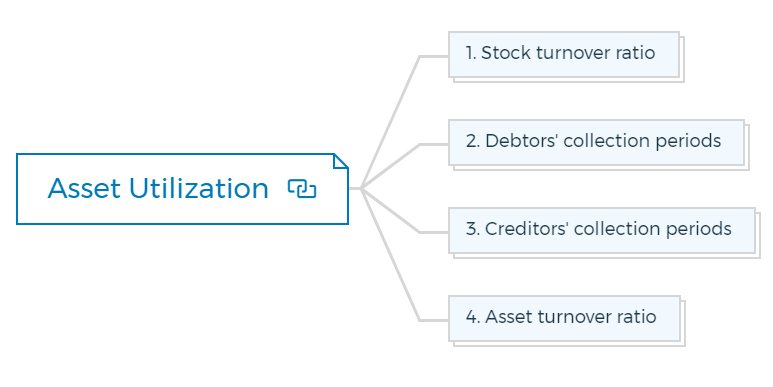
1. Stock turnover ratio

It shows the average holding period. The result depends on the stock held; it will be shortest if the stock has a short shelf-life.
2. Debtors' collection periods

It shows the account payment rate. Customers on credit are rare in retail, whereas builders' merchants do most of their business on credit.
3. Creditors' collection periods

Accounts for products and services are paid swiftly. A payment delay can be a cheap source of temporary financing, but continuous abuse of the credit facility will be noted by suppliers and may result in different treatment.
4. Asset turnover ratio

It measures the efficiency of sales asset utilization. This ratio shows the year-to-year trend. The ratio varies by company. It's beneficial for comparing similar companies.
Specialist valuers who use the profitability principle to value this asset will be familiar with the industry norm for the key ratios and will be alerted if the findings deviate significantly.
5. The contractor's test
The contractors' test was created distinctly from other valuation methods. It is focused on determining a yearly or capital sum in the absence of market evidence.
When used to determine a net yearly value for rating revenue purposes or compensation payable where land is seized under compulsory powers, the test must give an equitable conclusion to be credible.
You can also use the technique to calculate capital worth estimations for balance sheet purposes. The goal of the test is to determine a value, which is accomplished by assessing the building's construction cost and the value of the land, taking into account obsolescence and disabilities as needed.

How to estimate costs?
The basis arbitrariness, the use of cost or adjusted cost as a substitute for value, and the lack of market value data leave room for disagreement. The parties' different viewpoints may be sincere, but they must be settled, and the data will be examined. Below is a more extensive explanation of costs.
Building costs
Modern, functional developed buildings usually have replacement costs. When a building was built in an extravagant style that isn't considered today, a substitute building should be assumed.
Cost estimates
There is a need to estimate the current cost as accurately as feasible in either scenario, including building, external, site, finance, and fees. The replacement building's cost is harder to estimate because it may not reflect current training.
One of the following approaches, or a mix of ways, should provide a reasonably accurate cost estimate. You can estimate the cost with the help of these 5 common methods.
Superficial area
The surface area approach is the most systematic way to estimate building expenses. Buildings are measured using the RICS Code of Measuring Practice.
The resultant unit price (usually per square meter) is applied to the area, with lump-sum increases for stores and other structures outside the main building, landscaping, and car parking, plus building finance and professional costs.
This approach does not represent the effect of plan shape on cost, and the valuer should be aware that deviation from a standard square or rectangular design will likely increase the cost.
Cubic content
Certain buildings may be easier to calculate by their cubic capacity. Height affects the estimation. In this method, arbitrary allowances to the building's measured height reflect the cost difference between a flat and sloped roof.
Elemental costs
Material and labor expenditures for each primary building component are totaled to determine the overall cost. Since top quantity surveyors adopted cost-planning, the approach has gained prominence.
It demands more construction knowledge and is more time-consuming to compile.
Unit costs
Schools, theaters, and motels can be priced using unit costs. Schools are priced per desk, theaters per seat, and hotels per room. Such an approach is unlikely to be beneficial unless the valuer has an extensive understanding of expenses in that area.
Of course, there will be regional variations and disparities in building quality and finishes.
Approximate quantities
Take off, price, and total quantities. Detailed blueprints facilitate this. Such an exercise would be costly and possibly outside a value surveyor's expertise.
The example below shows why a commercial interest rate wouldn't be acceptable for obtaining an annual value from the exercise's cost data. Part A evaluates existing properties, whereas Part B evaluates new ones.
Example -
A significant regional water board has finished the construction of its operational facilities. The land cost $700,000, while the building cost $5000,000.
- The development is the same size and serves the same purpose as a 60-year-old building next door.
- The new structure was constructed to meet increased demand.
- The original structure will remain operational.
An expert valuer used the contractor's test to arrive at a valuation of $2,850,000 for the existing building after subtracting 50% for age and obsolescence in general.
All of the board's buildings and land are owned by the board. Major capital projects are funded via an internal sinking fund established.
The following example shows the two premise approaches.
Valuation A - Existing Premises
Cost of building = $5,000,000
Land value = $700,000
Add
Total = $5,700,000
Less
Obsolescence at 50% = $2,850,000
Total = $2,850,000
Annual value at 5% = $142,500
Valuation B - New Premises
Building cost = $5,000,000
Add
Land Value = $700,000
Total = $5,700,000
Annual value at 5% = $285,000
Eight ways to measure a property's value
Real estate investors' preferences, levels of experience, and available funds impact what they invest in. These decisions depend on the investor's equity and experience. Moreover, investors' profit objectives and yield expectations vary.
Individual investors make the final investment decision, but a qualified lawyer and accountant should be involved. Before making an investment decision, consider the following factors.
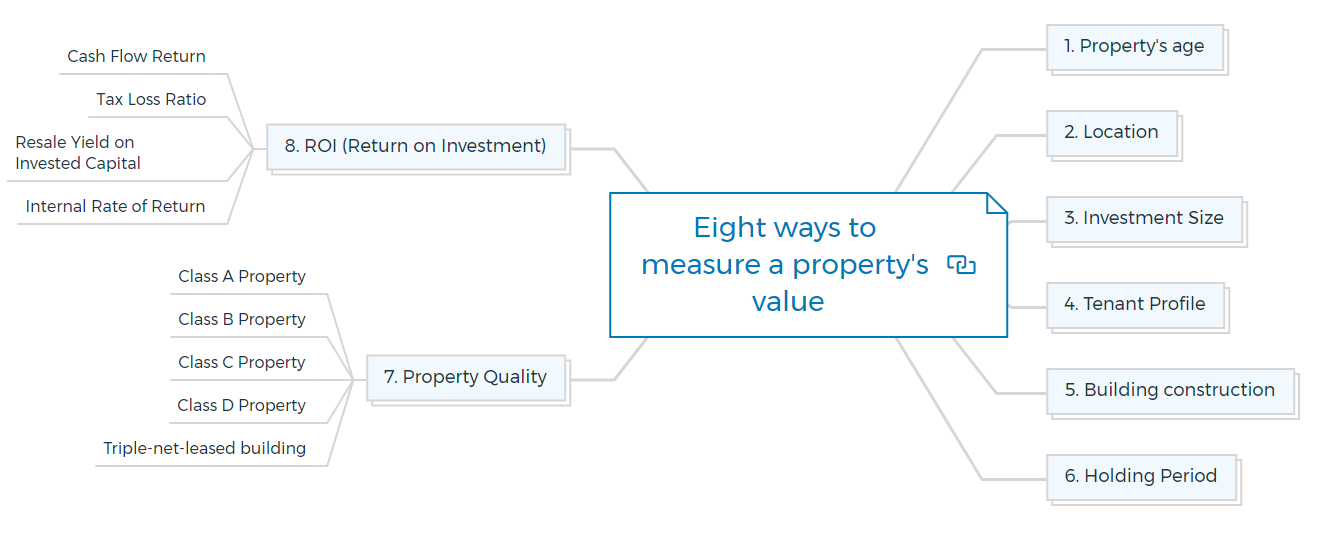
1. Property's age
After deciding on the type of real estate to invest in, you should decide on the property's age. Some investors only invest in new construction, while others prefer buildings under five years old.
Other investors focus on older properties that need renovation or repurposing. Remember that older homes, while often offering great potential, often necessitate extensive construction knowledge.
The beginning investor should focus on properties that need "face lifting" rather than complex structural renovations. An investor with construction skills won't mind older projects that need structural and cosmetic upgrades.
2. Location
The old saying Location, location, location is crucial. When examining markets, you move from the macro to the micro. In other words, the investor should first decide where to invest. Then, divide this by state, city, and submarket.
Given investors have demographic needs, such as population, average income, employment growth trends, traffic counts (number of automobiles passing a specific region daily), and vacancy rates.
Urban Decision Systems and National Decision Systems provide demographic data, whereas municipal or state traffic bureaus provide traffic count data.
You should examine accessibility, community services, and traffic flow at the building site.
3. Investment size
Every investor's bank account is unique. The investor must determine available equity. The deal's purchase price will vary depending on the investor's equity and leverage (borrowing funds).
Real estate investors should never risk more money than they can afford to lose or tie up indefinitely in a non-liquid venture.
4. Tenant profile
Each investor has tenant-profile criteria. Some residential investors choose white-collar properties, while others prefer blue collar.
Purchase price and terms often determine tenancy type. Some commercial buyers want 'Fortune 500' type tenants, while others prefer local tenants.
5. Building construction
Like consumers, investors have diverse tastes. Brick apartment units cost cheaper to maintain than wooden ones; thus, some investors prefer them. Other investors prefer sloped roofs over flat ones.
Many investors prefer individual apartment utility meters to a building-wide master meter. Past experiences often influence construction preferences. After having trouble with a flat roof, an investor is hesitant to buy another one.
Property buyers also consider landscaping. Image-conscious investors desire a lush, well-kept look. Investors trying to add value may buy a run-down property. An investor can raise the value of a neglected or distressed house by remodeling the outside and inside.
The investor can improve the property's image and thus attract a higher-paying tenant. Remember that a property's value increases with its revenue.
6. Holding period
Each investor should select the holding time. Some want to buy, fix homes, raise rents, and resell rapidly. Others invest long-term. Insurance firms and pension funds have enormous sums to invest each year, preferably in the long-term property.
Many limited partnerships plan to invest for ten years. During the holding period, investors frequently change their criteria. Many factors influence resale decisions.
Some investors resell because they lack working capital and don't want to recapitalise. Others are cash-strapped. Tax-oriented limited partnerships resale to reduce tax benefits.
In the fifth to the seventh year, depreciation deductions are reduced, and cash flow is no longer protected. Disagreements between partners are another reason.
7. Property quality
As with property kinds, real estate quality varies. Each investor must decide what quality he can afford. Quality costs more. Lower-quality homes cost less. These can be the most profitable.
Beginners should look for "Class B" or lower properties as given below. These properties need TLC but have the most profit potential.
Class A property
Class A homes are "postcard-quality" investments. They have prime locations and tenancy.
They command the most excellent pricing. These properties are often priced and sold above their economic value. Large insurance firms, pension funds, and banks often bid up these homes' values.
Class B property
Class B properties are staples. They're in great locations, but they don't have Class A tenants. Class A office building will have a 'Fortune 500' corporation's regional office, whereas Class B will have a local company. A Class B property may be older in a newer-building market.
Older leases may cut rents. You can usually buy these buildings for less than Class A properties. For example, the quality of renters might affect the price of a building.
Whereas Class A property owners can demand total cash from bidders, Class B property owners may obtain a reduced price or be required to refund mortgages.
Class C property
These types of properties are turnaround properties either mismanaged or have run out of funds. They will have high vacancy rates and neglected maintenance.
Unrepaired roofs or outmoded mechanical systems are examples of neglected maintenance. It may be possible to turn the property around and make a tidy profit with a bit of innovation and low-cost aesthetic repairs that can substantially improve the property's exterior.
You could find an older, neglected shopping complex, give it a new facade and various tenants, and charge both existing and new tenants more rent. Such assets give the most significant rewards, but they also work more.
Class D property
Poorly located, designed, or built properties or this type of property may have no market. Even with unlimited funds, it's hard to boost its value. These assets aren't as promising as others.
Property on the wrong side of town cannot be shifted and may never attract the right renters. A poorly planned, non-structurally altered building would struggle to attract quality tenants. Correcting inherent building problems in a poorly constructed project may also be financially impossible.
Triple-net-leased building
Triple-net leased property has a long-term lease. This investment might be a gem with a good tenant and a long-term lease (with yearly escalations).
Triple net leases require tenants to pay rent and all property expenses.
All the investor has to do is collect rent and pay the mortgage. The tenant handles daily issues. With a good lease and renter, the property's value should rise.
8. ROI (Return on Investment)
Investors must first identify their desired return. Expectations and measuring methods differ by an investor.
There are mainly 5 important approaches that can help you manage your ROI. Cash flow, tax-loss ratio, the resale yield on invested capital, the resale yield on the purchase price, and IRR.


Cash flow return
Current cash flow is the money left over after all bills are paid. Some investors want more significant returns than others. Cash flow is variable. In a tight rental market, investors can get higher rents.
Operating costs might skyrocket during periods of stable inflation, reducing cash flow. Financing plays a significant role. High rates increase debt service costs.
Some investors may want a 10% ROE. Others may accept less financial flow.
The example's return was 9.52 per cent.
$1142/$12000 = 9.52%
Some investors accept a lower return for several reasons. Some bought the property for appreciation. With inventive thinking and aggressive management, an investor could raise the value of a Class C property. Others bought the land as a land play.
Tax loss ratio
The tax-loss ratio measures investment return. Divide total taxable income or loss by current investment contribution.
Using the prior example number, you can calculate this tax loss ratio.

$2985/$12000 = 24.87%
The first-year tax loss ratio was 24.87%. The tax loss ratio would have been more significant if the investor had contributed stock over time.
If the down payment was $12,000 and only $6,000 was paid at closing, the tax loss ratio for the first year would be 49.75 per cent.
$2985/$6000 = 49.75%
Resale yield on invested capital
We can calculate the resale yield on invested capital by dividing the profit by the total capital investment. Five years after investing $12,000, the investor sold the property for $140,000.
With a profit of $40,000, 333 per cent of the original investment was resold.

$40000/$12000 = 333%
333%/5 = 66.66%
Total yield = 66.66% per year.
Resale Yield on Total purchase price
Total profit divided by original purchase price equals resale yield. Based on the initial $100,000 buying price, the investor made $40,000. There is a 40% annual return.
$40,000/$100000 = 40%
40%/5 = 8%
Total Yield = 8%
Internal Rate of Return
This is how many sophisticated investors project and assess their ultimate investment return. They can forecast future returns using current property operations based on future property and economic performance assumptions.
This rate estimates the money invested and delivers a return based on cash flow and projected resale cash flow. This tool calculates after-tax returns. This return can compare investment opportunities.
This return is only as good as the assumptions utilized in its formula. Astute investors must project high and low returns or best-case and worst-case possibilities.
FAQs

